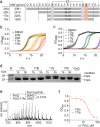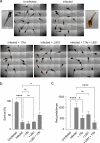Covalent Proteomimetic Inhibitor of the Bacterial FtsQB Divisome Complex
- PMID: 35945166
- PMCID: PMC9413201
- DOI: 10.1021/jacs.2c06304
Covalent Proteomimetic Inhibitor of the Bacterial FtsQB Divisome Complex
Abstract
The use of antibiotics is threatened by the emergence and spread of multidrug-resistant strains of bacteria. Thus, there is a need to develop antibiotics that address new targets. In this respect, the bacterial divisome, a multi-protein complex central to cell division, represents a potentially attractive target. Of particular interest is the FtsQB subcomplex that plays a decisive role in divisome assembly and peptidoglycan biogenesis in E. coli. Here, we report the structure-based design of a macrocyclic covalent inhibitor derived from a periplasmic region of FtsB that mediates its binding to FtsQ. The bioactive conformation of this motif was stabilized by a customized cross-link resulting in a tertiary structure mimetic with increased affinity for FtsQ. To increase activity, a covalent handle was incorporated, providing an inhibitor that impedes the interaction between FtsQ and FtsB irreversibly. The covalent inhibitor reduced the growth of an outer membrane-permeable E. coli strain, concurrent with the expected loss of FtsB localization, and also affected the infection of zebrafish larvae by a clinical E. coli strain. This first-in-class inhibitor of a divisome protein-protein interaction highlights the potential of proteomimetic molecules as inhibitors of challenging targets. In particular, the covalent mode-of-action can serve as an inspiration for future antibiotics that target protein-protein interactions.
Conflict of interest statement
The authors declare no competing financial interest.
Figures





Similar articles
-
Structural Analysis of the Interaction between the Bacterial Cell Division Proteins FtsQ and FtsB.mBio. 2018 Sep 11;9(5):e01346-18. doi: 10.1128/mBio.01346-18. mBio. 2018. PMID: 30206170 Free PMC article.
-
Fine-mapping the contact sites of the Escherichia coli cell division proteins FtsB and FtsL on the FtsQ protein.J Biol Chem. 2013 Aug 23;288(34):24340-50. doi: 10.1074/jbc.M113.485888. Epub 2013 Jul 11. J Biol Chem. 2013. PMID: 23846696 Free PMC article.
-
A model for the Escherichia coli FtsB/FtsL/FtsQ cell division complex.BMC Struct Biol. 2011 Jun 14;11:28. doi: 10.1186/1472-6807-11-28. BMC Struct Biol. 2011. PMID: 21672257 Free PMC article.
-
Assembly and activation of the Escherichia coli divisome.Mol Microbiol. 2017 Jul;105(2):177-187. doi: 10.1111/mmi.13696. Epub 2017 May 25. Mol Microbiol. 2017. PMID: 28419603 Free PMC article. Review.
-
Bacterial cell division proteins as antibiotic targets.Bioorg Chem. 2014 Aug;55:27-38. doi: 10.1016/j.bioorg.2014.03.007. Epub 2014 Apr 4. Bioorg Chem. 2014. PMID: 24755375 Review.
Cited by
-
Mycobacterium tuberculosis FtsB and PerM interact via a C-terminal helix in FtsB to modulate cell division.J Bacteriol. 2025 Apr 17;207(4):e0044424. doi: 10.1128/jb.00444-24. Epub 2025 Mar 26. J Bacteriol. 2025. PMID: 40135878 Free PMC article.
-
Bicyclic Engineered Sortase A Performs Transpeptidation under Denaturing Conditions.Bioconjug Chem. 2023 Jun 21;34(6):1114-1121. doi: 10.1021/acs.bioconjchem.3c00151. Epub 2023 May 29. Bioconjug Chem. 2023. PMID: 37246906 Free PMC article.
-
Direct Quantification of Protein-Protein Interactions in Living Bacterial Cells.Adv Sci (Weinh). 2025 May;12(19):e2414777. doi: 10.1002/advs.202414777. Epub 2025 Mar 24. Adv Sci (Weinh). 2025. PMID: 40125621 Free PMC article.
-
Peptide-based covalent inhibitors of protein-protein interactions.J Pept Sci. 2023 Jan;29(1):e3457. doi: 10.1002/psc.3457. Epub 2022 Nov 9. J Pept Sci. 2023. PMID: 36239115 Free PMC article. Review.
-
Insights into the assembly and regulation of the bacterial divisome.Nat Rev Microbiol. 2024 Jan;22(1):33-45. doi: 10.1038/s41579-023-00942-x. Epub 2023 Jul 31. Nat Rev Microbiol. 2024. PMID: 37524757 Free PMC article. Review.
References
Publication types
MeSH terms
Substances
LinkOut - more resources
Full Text Sources
Molecular Biology Databases

